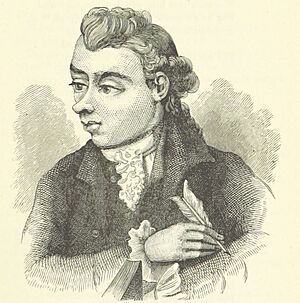Robert Fergusson facts for kids
Quick facts for kids
Robert Fergusson
|
|
|---|---|
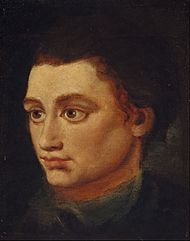
Portrait by Alexander Runciman, 1772
|
|
| Born | 5 September 1750 Edinburgh (Capital City), Scotland |
| Died | 16 October 1774 (aged 24) Darien House, Edinburgh, Scotland |
| Occupation |
|
| Nationality | Scottish |
| Alma mater | University of St Andrews |
| Literary movement | Scots vernacular revival |
| Notable works |
|
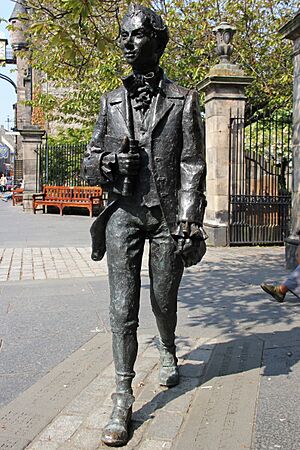
Robert Fergusson (born September 5, 1750 – died October 16, 1774) was an important Scottish poet. After studying at the University of St Andrews, Fergusson lived a free-spirited life in Edinburgh. This was the city where he was born, and it was a very exciting place for new ideas and culture during the Scottish enlightenment.
Many of his poems were printed starting in 1771 in Walter Ruddiman's Weekly Magazine. A collection of his works was first published in early 1773. Even though he lived a short life, his writing had a big impact, especially on the famous poet Robert Burns. Robert Fergusson wrote in both Scottish English and the Scots language. He is best known for his lively and skillful writing in Scots.
Contents
Robert Fergusson's Early Life
Robert Fergusson was born in a building in Edinburgh, Scotland. His parents, William and Elizabeth, were from Aberdeenshire. They had moved to Edinburgh two years before Robert was born. His father worked as a clerk at the British Linen Bank. Robert was the third of their three children who survived.
Schooling and University Days
Fergusson went to school at the High School in Edinburgh. He also attended the High School of Dundee. In September 1765, he started at the University of St Andrews. He received help from a special fund for his family, the clan Fergusson bursary.
At university, he learned about writing and literature from Robert Watson, a professor of Logic. He was also very good at math, taught by William Wilkie. In 1768, the university principal almost expelled Fergusson because of a "student riot." However, Professor Wilkie convinced him not to. Fergusson was about to finish his studies and promised to help Wilkie organize his notes. Fergusson did not officially graduate, but this was common back then and not seen as a failure. He kept his promise and helped Professor Wilkie. Later, he even wrote a poem called "Eclogue" in Wilkie's memory.
Returning to Edinburgh
In late 1768, Fergusson moved back to Edinburgh. His father had passed away the year before. His sister Barbara had gotten married, and his older brother Harry had left Scotland to join the Royal Navy after his business failed. Because of this, Fergusson, who had not finished his university studies, likely had to help support his mother.
His uncle, John Forbes, stopped helping him after they had an argument. Fergusson had decided not to become a church minister, doctor, or lawyer, even though his university training could have led to those jobs. Instead, he settled in Edinburgh and became a copyist, just like his father.
Robert Fergusson's Writing Career
There is good proof that Fergusson wanted to be a writer even when he was a student. He said he started writing a play about the life of William Wallace back then. His earliest poem that we still have is a funny poem in Scots. It was written about the death of David Gregory, a math professor at his university.
Joining Edinburgh's Creative Scene
Fergusson became part of Edinburgh's social and artistic groups. He spent time with musicians, actors, artists, and people who published books. His friend, William Woods, who managed a theater, often got him free tickets to plays. In 1769, Fergusson became friends with an Italian singer named Giusto Fernando Tenducci. Tenducci was performing in an opera called Artaxerxes.
Fergusson's first published work came when Tenducci asked him to write some Scottish songs for the opera's performances in Edinburgh. Fergusson wrote three songs. They were performed and printed along with the opera's script.
Poems in the Weekly Review
After February 1771, he started writing poems for Walter Ruddiman's Weekly Review. At first, these poems were usually in English. They were either funny (satirical) or about nature (pastoral), like the popular poems of William Shenstone. His first poem in Scots, called The Daft Days, was published on January 2, 1772. From then on, he wrote poems in both English and Scots.
People really liked his Scots poems. Many letters written in verse praised his work. This helped convince Ruddiman to publish a first collection of his poems. It came out in early 1773 and sold about 500 copies. This allowed Fergusson to make some money.
In mid-1773, Fergusson tried to publish his own poem, Auld Reekie. This poem is now seen as his best work. It is a lively poem that describes his home city of Edinburgh. He planned for it to be the first part of a longer poem. This showed his goal to write even more in Scots. He also hoped to translate parts of Virgil's Georgics into Scots, following in the footsteps of Gavin Douglas. However, if he wrote any drafts for this project, none of them survived. Fergusson was very critical of his own work and was known to destroy his writings later in life.
The Cape Club
Fergusson was a member of the Cape Club. This club met regularly at a tavern in Craig's Close. Each member had a special name and character they had to act out at every meeting. David Herd, who collected famous Scottish songs, was the "sovereign" of the Cape Club. His club name was "Sir Scrape."
When Fergusson joined, he was given the title "Sir Precentor." This was because he had a very good singing voice. Famous artists like Alexander Runciman, his student Jacob More, and Sir Henry Raeburn were also members. The old club records have many drawings by these artists. One interesting drawing, thought to be by Runciman, shows Fergusson acting as "Sir Precentor."
Robert Fergusson's Final Years
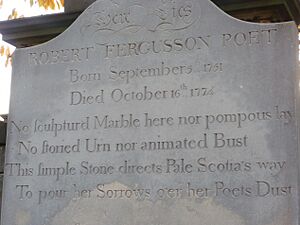
Fergusson's busy writing life and active social life were later affected by what might have been mental health struggles. From around mid-1773, his poems that we still have seem to become sadder. In late 1773, he wrote a poem about John Cunningham, another poet who had died in a hospital for mental health. In this poem, Fergusson expressed fears that he might face a similar fate.
His fears came true. Around late 1774, after getting a head injury in unclear circumstances (he fell down stairs in Edinburgh), Fergusson was admitted against his will to Edinburgh's Darien House "hospital." This was a place for people with mental health problems. After only a few weeks, he suddenly died. He had just turned 24 years old. He was buried in an unmarked grave in the Canongate Kirkyard.
The poet Robert Burns later paid for a memorial headstone for Fergusson in 1787. It was put up in 1789. The stone was fixed up in 1850 by the poet Robert Gilfillan. Later, in the 1800s, Robert Louis Stevenson wanted to fix the stone again, but he died before he could. The words Stevenson planned to add to the stone are on a plaque placed at the grave in 1995 by the Saltire Society.
Remembering Robert Fergusson
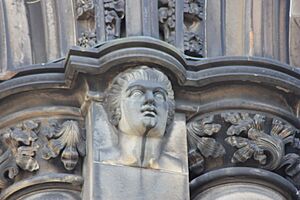

Robert Fergusson is one of sixteen Scottish poets and writers shown on the lower part of the Scott Monument on Princes Street. You can see him on the right side of the west face, across from Robert Burns.
A plaque was put up in his memory in St Giles' Cathedral in the 1930s.
A statue of Robert Fergusson was unveiled outside Canongate Churchyard on October 17, 2004. This statue was chosen after a competition to create a memorial for him. The artist who made it was David Annand.
His Impact and Legacy
Fergusson's poems were about both city life and country life. He was often good at making fun of things (satirist) and generally had Scottish nationalist ideas. Even though he didn't write a huge amount, his work is an important link between the poets of Allan Ramsay's time (1686–1758) and most later writers in Scots.
His career, where he wrote in two languages, was a clear inspiration for Robert Burns. Many important Scottish poets of the 1900s, like Robert Garioch and Sydney Goodsir Smith, also knew how important he was. However, more generally, his legacy has often been unfairly forgotten.
Many of Robert Burns's works either sound like or are directly based on Fergusson's poems. For example, Fergusson's "Leith Races" clearly inspired Burns's "Holy Fair." "On seeing a Butterfly in the Street" by Fergusson has ideas that are very similar to Burns's "To a Mouse." When you compare poems like Fergusson's "The Farmer's Ingle" and Burns's "The Cotter's Saturday Night," you can see how complex and creative Fergusson's influence was.
Fergusson's life also had an important impact beyond literature. The sad way he died led one of his visitors at Darien House, a young doctor named Andrew Duncan, to push for better ways to treat mental health problems. This led to the creation of what is now the Royal Edinburgh Hospital.
See also
 In Spanish: Robert Fergusson para niños
In Spanish: Robert Fergusson para niños
- Habbie stanza
- Scottish literature
- Scots language
- Thomas Chatterton


